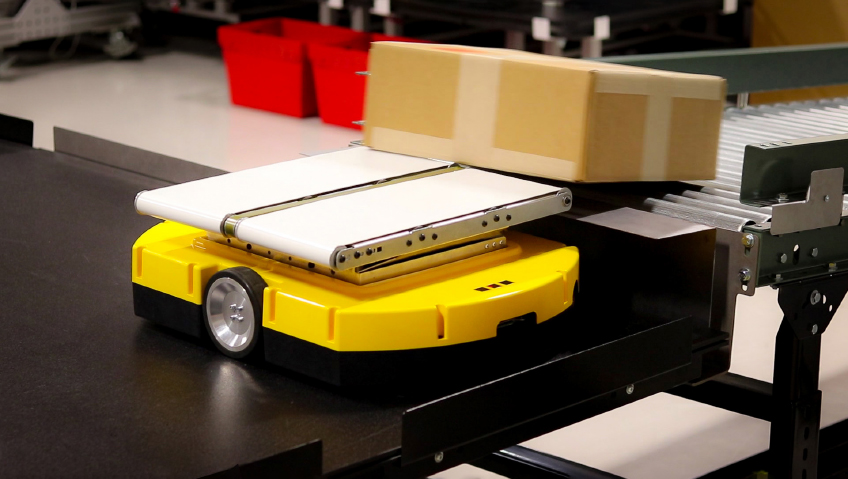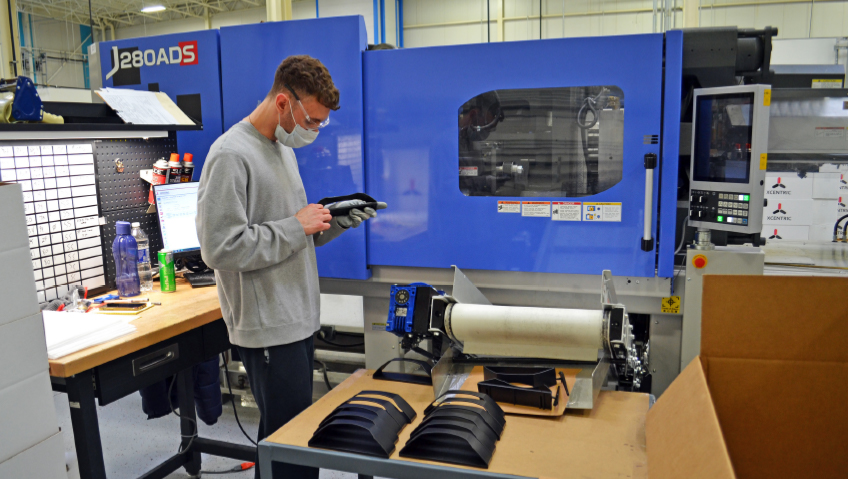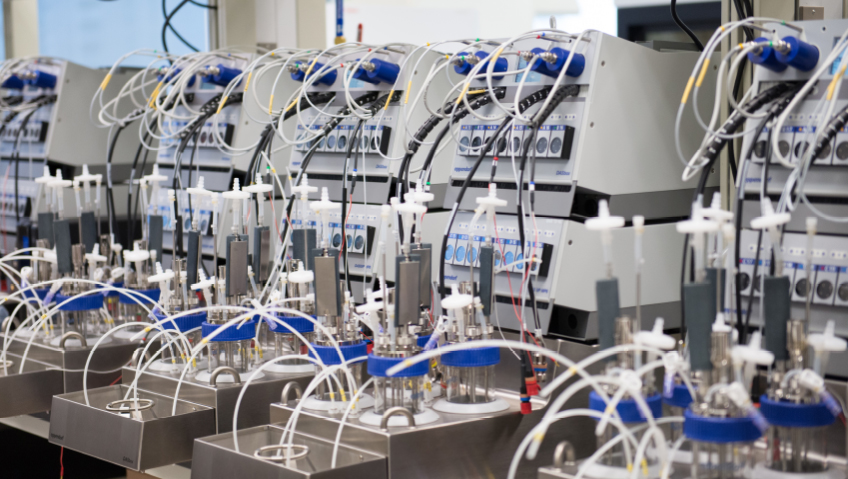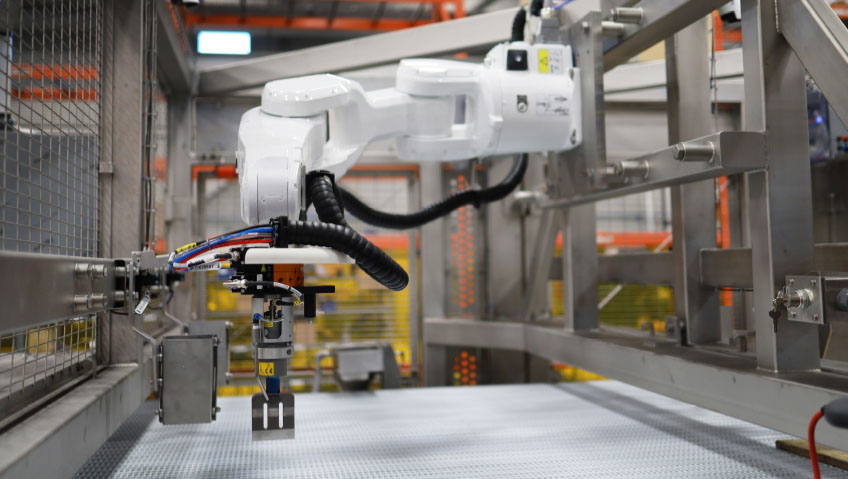Serving with Tompkins Robotics as President since its 2017 inception and named Chief Executive Officer earlier this year, Mike Futch is seeing the company advance beyond anyone’s expectations despite the pandemic.
Speaking about the robotics sector in particular, Mike Futch’s excitement on the topic is immediately obvious and palpable. Holding a degree in Industrial Engineering from North Carolina State University and working in civil engineering with the United States Air Force, Futch has dedicated decades of his life to the automation industry, holding senior leadership roles with global supply chain and logistics companies.
“COVID was a short-term setback, and we are on a tremendously fast growth trajectory that started in the fall of 2020,” he says of Tompkins Robotics, one of the leading providers of autonomous mobile robot (AMR) systems and solutions. “We have an exciting list of customers, are doing major, multi-site rollouts, and are making a real difference in clients’ operations. We even have multiple systems where we are doing e-commerce, order fulfillment and store replenishment in the same system in a retailers’ operation.”
With retail as its number one sector – including online, e-commerce-only clients, store-based clients, and a combination of both – Tompkins is meeting the order fulfillment needs of 9 of the top 30 and others in the top 250. Tompkins’ second biggest client base is shippers and package handling companies. All of the company’s customers are seeing increased business either during COVID or in the current period as we move to a more normal life.
At the start of the pandemic, grocery stores and businesses of all kinds had to pick up the pace as bricks-and-mortar retailers closed, and online orders from consumers and businesses alike skyrocketed. Products from pineapples to printer ink needed to be sourced, packaged, and delivered faster than ever.
“The fact of the matter is, COVID has jump-started the entire robotics automation industry,” Futch says. “We will be this year and next year where we planned to be two years from now. It has greatly accelerated our growth.”
A combination of the health crisis and a shortage of workers in the labor market was the tipping point for businesses to switch to automation, with many fast realizing that a fleet of robotic elements would replace the fixed, long-lead time, inflexible systems of the past.
Exciting times
Based in Orlando, Florida, Tompkins Robotics was in the right place at the right time to serve its clients.
Before COVID, big companies would ship multiple items to stores which would put them on the shelves, and customers would come and make purchases. During the crisis, much more human labor was required. Customers placed online orders in smaller quantities – such as one to five different pieces per order – as opposed to products being sent in bulk to stores, and buyers getting the items themselves. This resulted in a much higher volume of high labor content orders in 2020 than 2019, before the pandemic.
“So if you’ve got a labor shortage and a labor content increase occurring simultaneously, you must automate in order to survive or keep your business from stagnating,” says Futch. “If you’re not fulfilling customer demand, it is a very bad thing for anyone’s business. Robotic automation is the way of the future, and the way it’s going to be for as far as we can see into the future. There’s no turning back.”
Selling the bulk of its robotic sortation systems to customers across the United States and Canada, Tompkins Robotics is also growing its sales to Australia, New Zealand, and Europe in the coming months. In North America, Tompkins is the leader in robotic sortation, far ahead of the competition.
While others in the industry are supplying pedestal sorting robots running on floors using QR Codes (quick response), these systems have disadvantages.
Pedestal-based systems are slower, and take up more space since they only work on a single level. Since they have to travel greater distances to do the same amount of work, extra robots are needed, making systems more expensive compared to Tompkins’ robots, which run at a blistering 2.5 meters (8. 2 feet) per second.
“No one is doing exactly what we’re doing,” says Futch, “and even those who are doing something different – like the pedestal robots – are selling fewer robots than we are.”
Compact, speedy and scalable
As a contrast to large, cumbersome, and expensive robotic systems, Tompkins has the revolutionary tSort line.
Providing customers with the tSort, tSort Plus, tSort Mini, xPress and xChange models, and tilt-tray and cross-belt sortation methods, the company’s systems “can handle items as small as a penny to up to 40 inches (101 cm.) long by 30 inches (76 cm.) wide and weighing up to 120 pounds (54 kg.),” according to Tompkins.
Small and powerful, tSort, tSort Plus, and tSort Mini models are unlike other warehouse sortation systems on the market, and ideal for large and small scale e-commerce, returns, buy online pick up in-store (BOPIS) and other applications.
As the most flexible robotic sortation system available, the tSort is fast and scalable. Requiring about 50 to 75 percent less space than traditional sortation, it is optimized for flexibility and works with a range of products, process flows and applications.
And unlike traditional systems, tSort can be implemented in five to six months from contract signing. Traditional systems typically take a year or more currently. There have even been implementations in as little as two weeks in certain circumstances.
tSort micro-fulfillment solutions
Along with its size and speed advantages, the tSort can be put together like Lego blocks, which means it can then be made bigger or smaller as needed. “It is one-tenth of the cost, one-tenth of the space, and one-tenth of the lead time of the leading ASRS (automated storage and retrieval systems) micro fulfillment solutions,” says Futch.
A hybrid solution providing automation at a lower cost, tSort Micro-Fulfillment Solutions offers customers enhanced efficiencies, with Tompkins filling orders quickly and efficiently with minimal labor. Currently in contract negotiations with multiple online grocers in urban settings, multiple grocery chains and multiple large-format retailers, the system is practically selling itself, and for very good reason.
As small as 1,500 square feet (including the aisle around it), it is ideal for micro fulfillment businesses. Requiring little inventory, it saves money by using regular store stock. Combined with the xPress, an overhead robotic monorail system, product is quickly moved to and from the back room to the selling floor.
This helps minimize floor traffic, which has become an issue with Instacart shoppers who are now getting in the way of in-store buyers in grocery stores and other environments because of additional foot traffic. “Our version gets most of the traffic off the floor by allowing batch picking of 25 to 200 orders at a time with much fewer workers and using an overhead delivery system to move batched picked goods for orders to the backroom for sortation to unique orders. The xPress overhead robotic delivery system also can be used to restock the shelves and deliver completed orders to the customer interface for pickup,” says Futch.
Flexible and adapatable
Another way Tompkins Robotics’ tSort systems are unique is their adaptability to all kinds of spaces, even temporary ‘pop-up’ inflatable buildings in parking lots for last mile delivery during holiday peaks or for return sortation after the holiday season.
Unlike any traditional automation in the industry, every piece of the system is on wheels including platforms, induction stands, and chutes. “Imagine if you will – if you needed to roll into a certain area for a month or two, put a system up, and then take it down and move it someplace else, we can do that,” says Futch.
Classification as mobile equipment in North America means no sprinklers beneath the surfaces and no hard-wired electrical, which means permitting is not needed, another enormous advantage. Some customers are using their systems during the holiday season for online order fulfillment in January and the first half of February for post-Christmas returns in a temporary location, and then moving the portable system to a permanent building for a long-term automation upgrade. Their plans are to repeat this process across sites as they modernize their networks.
Since all parts interconnect and are plug-and-play, existing systems keep working without interruptions. “You just deliver the additional components, hook them all up, get the new robots running in that new isolated area. Then you stop for 30 minutes to map and integrate the new system addition, and you are up again,” says Futch. “It’s nothing like the traditional systems of the past.
Strategically partnering with others’ technology, and geographic integrator partners including SI Systems, Bastian Solutions, PULSE Integration, RightHand Robotics – and recently GreyOrange for its new “zero walk” solution that eliminates walking by human pickers in distribution centers – Tompkins continues to advance the robotics industry.
Speeding up post-COVID
Receiving recognition, including the 2020 NextGen Supply Chain Solution Provider Award, which came as a pleasant surprise to the company, since it was customers who nominated Tompkins, the business looks forward to a post-COVID world and to showcasing its systems in-person at MODEX, Groceryshop LLC, NRF, the Parcel Forum, LogiMAT, and other trade shows and exhibitions.
Constantly innovating, the company’s latest product is xChange, billed as “a new robotic sorter exit system” by Tompkins.
xChange automates completed order removals and does much to eliminate labor post-sortation, including greater process flow automation, and has even automated replacement with empty containers. Until now, after items were sorted to their destinations, a human had to be present to remove product from the chute, or replace one container with another.
“It’s never been done before,” Futch says. “It will be on the market in 2022. We are really excited about it, and have already sold the first system.”
To keep up with customer demand, the company is on the lookout for talented, enthusiastic people, and plans to double its existing 225 workers worldwide in the next 12 months, and expand operations to Europe and the Middle East.
Futch sums up: “We are going to continue to innovate, stay ahead of the market, and create new models, patent that technology and intellectual property, and keep moving forward. Our team has a mandate to stay ahead of whatever other people are thinking about.”






